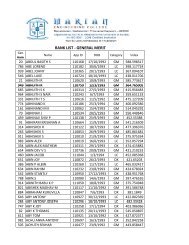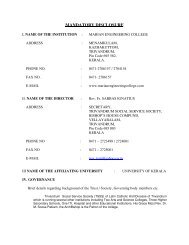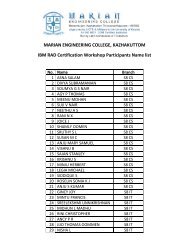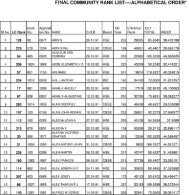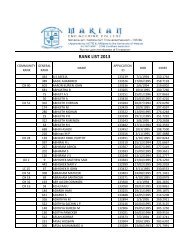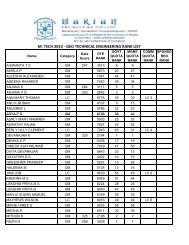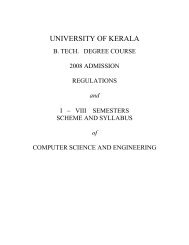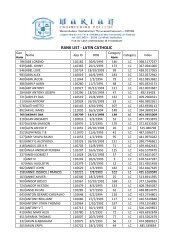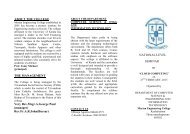UNIVERSITY OF KERALA - College of Engineering, Trivandrum
UNIVERSITY OF KERALA - College of Engineering, Trivandrum
UNIVERSITY OF KERALA - College of Engineering, Trivandrum
You also want an ePaper? Increase the reach of your titles
YUMPU automatically turns print PDFs into web optimized ePapers that Google loves.
08.606.1 ElectiveII SOIL EXPLORATION<br />
L T P/D Cr<br />
3 1 0 4<br />
Module I<br />
Objectives <strong>of</strong> soil exploration – Planning <strong>of</strong> a sub-surface exploration programme –Collection <strong>of</strong> existing<br />
information – Reconnaissance – Detailed investigation - Number, size, spacing and depth <strong>of</strong> boreholes –<br />
Different methods <strong>of</strong> exploration - Open pits and borings – Methods <strong>of</strong> boring – Auger boring, auger and shell<br />
boring, wash boring, percussion drilling, rotary drilling – Comparison <strong>of</strong> the methods<br />
Geophysical methods – Seismic refraction method – Procedure, uses, limitations – Electrical resistivity method<br />
– Electrical pr<strong>of</strong>iling and electrical sounding – Procedure, uses - Field determination <strong>of</strong> permeability by<br />
pumping out test[no derivation required]<br />
Module II<br />
Sounding methods – Standard Penetration Test – Procedure –Various corrections to be applied to observed N<br />
values – Factors influencing the SPT results and precautions to obtain reliable results – Merits/drawbacks <strong>of</strong> the<br />
test – Correlations <strong>of</strong> N value with various engineering and index properties <strong>of</strong> soils<br />
Static Cone Penetration Test – Procedure – Merits/drawbacks – Correlation <strong>of</strong> static CPT results with various<br />
soil properties - Dynamic Cone Penetration Test – Procedure – Merits/drawbacks – Critical comparison <strong>of</strong> SPT,<br />
static CPT and dynamic CPT<br />
Plate load test – Procedure, uses and limitations - Pressure meter test - Procedure –Uses<br />
Module III<br />
Soil sampling – Undisturbed, disturbed, and representative samples – Chunk and tube samples – Factors<br />
affecting sample disturbance and methods to minimize them – Area ratio – Inside clearance – Outside clearance<br />
– Recovery ratio – Ball check valve – Handling and transportation <strong>of</strong> samples – Extrusion <strong>of</strong> samples<br />
Types <strong>of</strong> samplers – Thin walled sampler – Piston sampler – Split spoon sampler - Core retainers – Liners –<br />
Rock cores – Types <strong>of</strong> drill bits – Rock Quality Designation –Bore log – Soil pr<strong>of</strong>ile – Sub-soil investigation<br />
report<br />
References:<br />
1. Gopal Ranjan & A.S.R Rao, ‘Basic and Applied Soil Mechanics’, New Age International (P) Limited, New<br />
Delhi, 2002<br />
2. K.R. Arora, ‘Geotechnical <strong>Engineering</strong>’, Standard Publishers Distributors, New Delhi, 2006<br />
3. Venkatramaiah, ‘Geotechnical <strong>Engineering</strong>’, Universities Press (India) Limited, Hyderabad, 2000<br />
4. Joseph E. Bowles, ‘Foundation Analysis and Design’, Mc. Graw Hill Inc., New York, 1988<br />
Question Paper:<br />
Duration:3 hours<br />
The question paper consists <strong>of</strong> Part A and Part B.<br />
Part A carries 40 marks. There will be 8 compulsory short answer questions covering entire syllabus.<br />
Part B is for 60 marks. There will be 2 questions from each module. The candidate has to answer one question<br />
<strong>of</strong> 20 marks from each module.<br />
59



